Brief profile
I am Professor Emeritus of the University of Tokyo and Visiting Professor
at Keio University. I received a Ph.D. in the ecological and morphological
studies of island birds from the University of Tokyo. I served as a visiting
research scientist at the University of Michigan and as Full Professor
of Biodiversity Science at the University of Tokyo. I am interested in
various aspects of Ecology and Conservation Biology, ranging from island
biology and bird migration through the conflicts between crows and humans
to the impact of climate change on birds and plants. I served as the Asian
Section President of the Society for Conservation Biology and the President
of the Ornithological Society of Japan.
Professional preparation
1975-1976 Research student, The University of Tokyo
1972-1975 Doctor program, The University
of Tokyo, Forest Zoology, Ph.D. 1975
1970-1972 Master program, Utsunomiya University, Applied
Zoology
1966-1970 Undergraduate, Utsunomiya
University, Applied Zoology
Appointments
2012- Professor Emeritus, The University of Tokyo
Visiting Professor, Keio University
1994-2012 Professor, The University of Tokyo
1988-1994 Director of Research
Center, The Wild Bird Society of Japan
1986-1988 Visiting Research Scientist, The University of Michigan
1977-1988 Assistant Professor, The University of Tokyo
1976-1977 JSPS Post-doctoral Fellow, The University of Tokyo
Back
TOP
Research interests
I am interested in various aspects of the evolution, ecology and conservation
of biodiversity. My main research target is birds, and research subjects
are grouped into six: 1) island biology, 2) adaptations for brood parasitism
in cuckoos, 3) origin and development of intelligent behavior of birds,
4) ecology and conservation of migratory birds based on satellite tracking,
5) conflicts between wildlife and humans, and 6) impacts of climate change
on biodiversity.
1) In the study of island biology, I compared the breeding and foraging
ecology between the mainland and island populations of varied tits, Parus varius. It was shown that the island population has smaller clutch size
and the exaggerated begging behavior of young than do the mainland population
and that such differences are related to the difference in the seasonal
fluctuation of food sources between the two populations (lower on the island).
I also studied the species composition of woodpeckers in each of the Japanese Islands, and discussed the results in relation to the size and remoteness of islands
and the presence and absence of closely related species.
2) In the study of brood parasitism by cuckoos, I have studied the laying
behavior, egg colors, and the morphology and behavior of young cuckoos,
and have shown how each of the characteristics contributes to the success
of brood parasitism. It became to know that the host selection and
egg color of one cuckoos species differ in the presence and absence of
other cuckoo species. For example, Himalayan cuckoos Cuculus saturatus lay whitish eggs into the nest of Phylloscopus willow warblers in the largest Honshu island where little cuckoos C. poliocephalus lay chocolate-colored eggs into the nests of bush warblers Cettia diphone laying the same colored eggs. On the other hand, in smaller Hokkaido island where
little cuckoos are missing, the Himalayan cuckoos lay chocolate-colored eggs
into the nest of bush warblers.

A bush warbler rearing a young little cuckoo
Higuchi (1998)
3) In the study on the origin and development of intelligent behavior, the main target species are green-backed herons Butorides striatus and Corvus crows. In green-backed herons, I showed bait-fishing behavior in southern
Japan, where the herons used various kinds of baits such as flies, cicadas,
earthworms, berries, leaves, twigs, and small feathers to attract and catch
fishes. I also collected similar cases reported from different parts
of the world, and discussed the possible developmental processes of the
behavior. In crows, I collaborated with Dr. Yoshiaki Nihei on a smart
behavior by carrion crows Corvus corone, in which automobiles are used to crack walnuts, and showed the ecological
characteristics of the localities where the behavior is found, the behavioral
diversity and plasticity, and the spread process of the behavior.
It became to know that some crows place a walnut just in front of a car
tire to make sure of cracking. I also studied the tap-turning behavior by a carrion crow and found that
the crow altered the force of the water depending on whether it was drinking
or bathing.
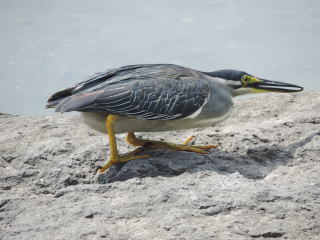
A bait-fishing green-backed heron.
Higuchi (1986, 1988)
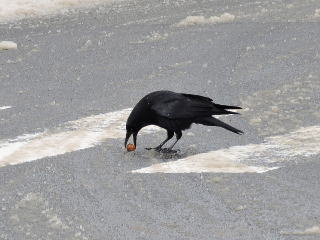
A carrion crow placing a walnut on street to crack by a car.
Nihei and Higuchi (2001)
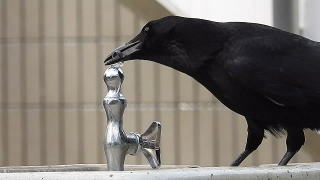
A carrion crow drinking water after turnig on the tap
Higuchi (2019)
4) In migration studies, I have collaborated with Russian, Mongolian, Korean,
Indian and American scientists on tracking the migration of swans, geese,
ducks, storks, cranes, and hawks for nearly 30 years. I have led
the research projects, and have shown the detailed migration routes, migration
pattern through time, habitat characteristics of important sites, and the
relative importance of each stopover sites based on the length of stay
and the number of birds visited. The results obtained have been used to
settle national or private nature reserves in North Korea and Russia and to evaluate the border of nature
reserves in China. Recently, these studies have been conducted in order to show the relationships
between bird migration and the spread of infectious diseases such as Avian
Influenza. Moreover, we also have used geolocators and other decives to track smaller
birds such as shrikes, starlings and swifts.
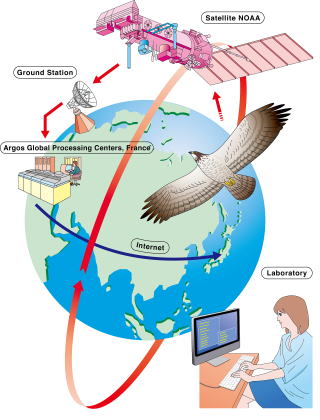
Mechanisms of satellite tracking. Illustrated by Michiko Shigehara.
Higuchi (2013, 2014)
 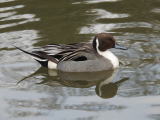
Spring migration routes of northern pintails. After Hupp et al. (2011)
 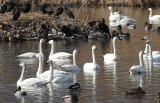
Spring migration routes of tundra swans.
Higuchi (2012), Chen et al. (2016)
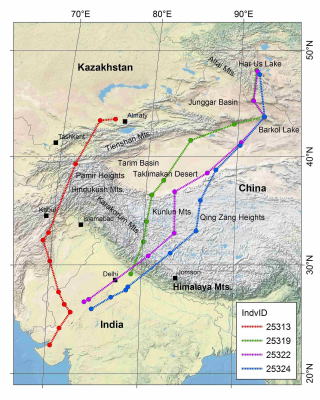 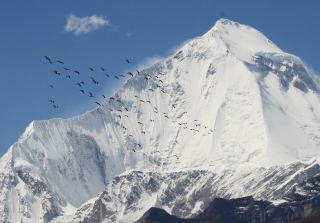
Autumn migration routes of Demoiselle cranes crossing over the Himalayas.
Higuchi and Minton (2017) Photo by Rajendra Suwal

Fall (left) and spring (right) migration routes of Oriental honey-buzzards.
Higuchi (2012)
 
Seasonal movements of Japanese murrelets, based on geolocator survey.
Yamaguchi et al. (2016) and Higuchi (2016). Photo by Hajime Tsumura
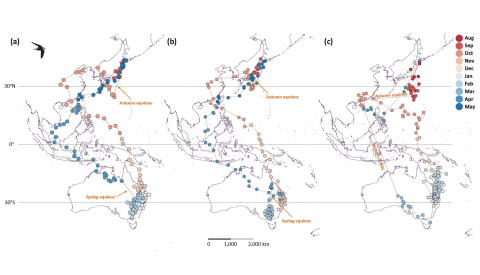
Migration of 3 individual White-throated Needletails, based on geolocator
survey.
Yamaguchi et al. (2021)
5) Studies on conflicts between wildlife and humans are grouped into two:
one on Corvus crows in Tokyo urban area and the other on white-fronted geese Anser albifrons in Hokkaido. In crow study, I studied stone-placing on rail road tracks, dispersing
garbage on street, attacking people, stealing soap bars from kindergarten,
and making field fire by putting alight candles among fallen leaves in
forest floors. I contributed to the resolutions by showing the behavioral
mechanisms. In geese study, my graduate students and I made detailed
field observations and model/computer simulations to show the occurrence
mechanism of damage on wheat and the appropriate resolution of the conflicts.

Jungle crows coming to garbage in Tokyo.
Ueta et al. (2003)
6) In the study on the impacts of climate change on biodiversity, I have
collaborated with American, Korean and Japanese scientists on changes in
the phenology and distribution of plants and animals. It is shown that
the breeding season of the red-cheeked myna Sturnus philippensis and the blooming season of the Somei-Yoshino cherry Cerasus x yedoensis in Niigata City have both advanced during the past
27 years, but the breeding season of the myna has advanced twice as much. As a
result, the fruit of the cherry on which the myna had relied to feed its chicks
until around the 1970s, can now be provided only in small quantities, since the
cherries are not sufficiently in fruit while the chicks are in the nest.
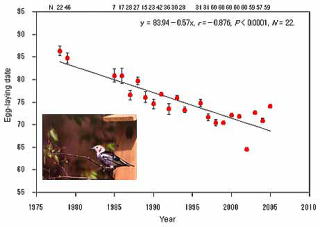
Yearly changes in the first egg-laying date of red-cheeked mynas.
Koike and Higuchi (2002), Koike et al. (2006)
Back
Educational Programs
My colleagues and I held several educational programs such as Satoyama
Concert and Satellite-tracking Open to the Public. In the Satoyama Concert,
a singer, a pianist, a violinist, a dancer and a biologist collaborated
to provide music and talks associated with Satoyama natural history. In
the Satellite-tracking Open to the Public, we opened the real-time satellite-tracking
of four individual Oriental Honey-Buzzards migrating between Japan and
South-East Asia. Tracking information was also provided in 5 different
languages of Japanese, Chinese, Korean, Indonesian and English. Tens of
thousands people joined to enjoy this program.
★ Swan Project
Swanback Marvelous Journey (intelinkgo.com)
Period: January 2024~
Organized by :
The Miyagi Prefectural Izunuma-Uchinuma Environmental Foundation
Hamatonbetsu Lake Kutcharo Waterfowl Observatory
Druid Tecnology Co., Ltd
Served as advisor
★Satoyama Concert
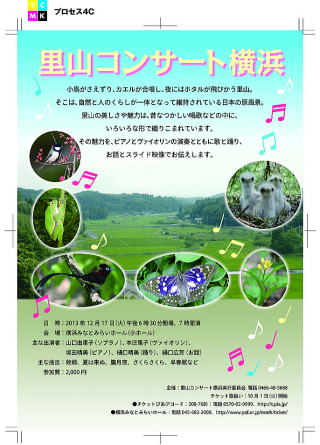
Brochure of Satoyama Concert Yokohama 2013

Satoyama Concert Yokohama 2013
★Satellite-tracking Open to the Public (Hachikuma Project)
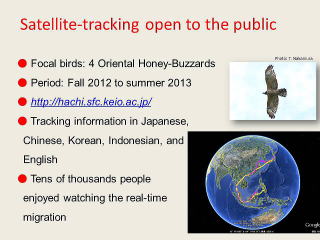
Hachikuma is the Japanese name of the Oriental Honey-Buzzard. The buzzards
traveled between the breeding ground of Japan and the wintering ground
of Indonesia.
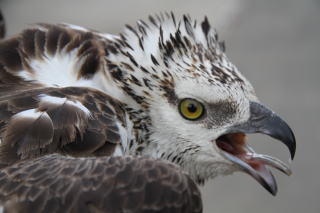
An Oriental Honey-Buzzard named "Nao", one of the 4 individuals
tracked for Hachikuma Project. Photo by Ken'ichi Tokita.
★"Donate For Birds" Project 2016

http://donateforbirds.com/
Educational and donation activities for saving endangered birds through twitter
Hosted by Conservation International Japan and others
Supervised by Hiroyoshi Higuchi
TOP
Publications
Reviewed English articles
2025
219. Otsubo, J. and Higuchi, H. (in press). Estimation of the population size of the short-tailed albatross Phoebastria albatrus on the Senkaku islands using satellite images. Endangered Species Research.
218.
Mizumura, H., Kubota, K. and Higuchi, H. (accepted). Breeding habitat selection and conservation of the Grey Nightjar Caprimulgus jotaka in volcanic grasslands. Ornithological Science
217. Shimada, T., Konishi, K., Li, G., Shi, G. and Higuchi, H. (2025). Swan Project promotes citizen science initiative through a public
bird migration tracking. Avian Research 16 (4)
https://www.sciencedirect.com/science/article/pii/S2053716625000775
216. Seki, S., Yamaguchi N., Fujita, K., Mizuta, T. and Higuchi, H. (accepted). Geographic variation in clutch size of the Varied Tit in
East Asia: latitudinal gradient along the Japanese Islands. Ornithological
Science
215. Gu, D., Xie, Y., Shimada, T., Higuchi, H., Solovyeva, D., Bysykatova-Harmey, I., Liu, Y., Zhang, J., Zhao, Q., Cao,
L. and Fox, A. D. 2025. Reconciling Bergmann’s rule throughout the annual
cycle in two congeneric large-bodied migratory waterbirds. Avian Research
16(3)
https://doi.org/10.1016/j.avrs.2025.100263
214. Komura, T., Hagiwara, Y., Horie, G., Yokoyama, Y., Tago, K. and Higuchi, H. 2025. Seabird distribution in coastal area of Japan revealed by aerial
survey. Pacific Science78:261–277.
https://doi.org/10.2984/78.3.3
213. Meirani, U., Prasetyo, L. B., Mulyani, Y. A., Syartinilia and Higuchi, H. 2025. Land cover dynamics and Oriental Honey-buzzard winter habitat preference
in Borneo, Indonesia. Journal of Natural Resources and Environmental Management
15:111-121
https://journal.ipb.ac.id/index.php/jpsl/article/view/50506/29937
2024
212. Liu, W., Zhang, J., Shimada, T., Xie, Y., Batbayar, N., Higuchi, H., Damba, I., Cao, L. and Fox, A. 2024. Life in the fast and slow lanes:
contrasting timing of annual cycle events in high‐ and mid‐latitude breeding
Whooper Swans (Cygnus cygnus). Ibis 166:1157-1171.
https://doi.org/10.1111/ibi.13339
211. Ono, H., Nagai, K. and Higuchi, H. 2024. Dark morph of the Oriental Honey-Buzzard (Pernis ptilorhynchus orientalis) is attributable to specific MC1R haplotypes. Zoological Science 41:342-350.
https://doi.org/10.2108/zs230092
210. Wu, Y., Lin, Y. C. and Higuchi, H. 2024. Night landing of Grey-faced Buzzards (Butastur indicus) on a ship during migration. Journal of Raptor Research 58:125-128.
https://doi.org/10.3356/JRR-23-00047
2023
209. Mizumura, H., Kubota, K., Nishiumi, I., Imanishi, S, Mochizuki, M.
and Higuchi, H. 2023. Hybridization and backcrossing between the endangered Brown Shrike
(Lanius cristatus superciliosus) and the common Bull-headed Shrike (L. bucephalus). Biological Journal of the Linnean Society 142:81–90.
https://doi.org/10.1093/biolinnean/blad117
208. Higuchi, H., Yonekawa, H., Mori, S., Konno, S., Konno, M., and Yamaguchi, N. M. 2023.
Structure and possible functions of the tail 'needles' in the White-throated
Needletail. British Birds 116:168-172.
207. Fujita, K., Fujita, G. and Higuchi, H. 2023. Ecological determinants of inter-island distributions through occasional
dispersals of two closely related species, Varied Tits and Japanese Tits,
in a volcanic archipelago, the Izu Islands, Japan. Ornithological Science
22:67-79.
https://doi.org/10.2326/osj.22.67
2022
206. Yi, K., Zhang, J., Batbayar, N., Higuchi, H., Natsagdorj, T., and Bysykatova, I.P. Using tracking data to identify
gaps in knowledge and conservation of the critically endangered Siberian
crane (Leucogeranus leucogeranus). Remote Sensing 14, 5101. https://doi.org/ 10.3390/rs14205101
205. Condro, A. A., Syartinilia, Higuchi, H., Mulyani, Y. A., Raffiudin, R., Rusniarsyah, L., Setiawan, Y., and Prasetyo,
L. B. 2022. Climate change leads to range contraction for Japanese population
of the Oriental Honey-Buzzards: Implications for future conservation strategies.
Global Ecology and Conservation 34: e02044. https://doi.org/10.1016/j.gecco.2022.e02044
204 Syartinilia, Mulyani, Y. A., Makalew, A. D. N. and Higuchi, H. 2022. Modeling the wintering habitat distribution of Oriental Honey Buzzards
in West Java Indonesia with satellite tracking data using logistic regression.
HAYATI Journal of Biosciences 29:9-21.
https://journal.ipb.ac.id/index.php/hayati/article/view/38696/22554
203. Hijikata, N., Yamaguchi, N. M., Hiraoka, E., Nakayama, F., Uchida,
K., Tokita, K. and Higuchi, H. 2022. Satellite tracking of migration routes of the eastern buzzard (Buteo japonicus) in Japan through Sakhalin. Zoological Science 39(2),
https://doi.org/10.2108/zs210071
202. Otsubo, J. and Higuchi, H. 2022. Arrival and breeding timing of short-tailed albatrosses (Phoebastria albatrus) revealed from time-lapse camera photographs. Endangered Species Research
47: 49-59.
https://doi.org/10.3354/esr01160
2021
201. Nourani, E., Bohrer, G. , Becciu, P., Bierregaard, R. O., Duriez,
O., Figuerola, J., Gangoso, L., Giokas, S., Higuchi, H., Kassara, C., Kulikova, O., Lecomte, L., Monti, F., Pokrovsky, I., Sforzi,
A., Therrien, J-F., Tsiopelas, N., Vansteelant, W.M.G, Viana, D. S., Yamaguchi,
N. M., Wikelski, M. and Safi, K. 2021. The interplay of wind and uplift
facilitates over-water flight in facultative soaring birds. Proceedings
of the Royal Society B: Biological Sciences 288. https://royalsocietypublishing.org/doi/10.1098/rspb.2021.1603
200. Mizumura, H., Kubota, K., and Higuchi, H. 2021. The endangered Brown Shrike subspecies Lanius cristatus superciliosus has a male biased sex ratio and only early arriving males are paired. Bird
Conservation International 32: 87-94.
https://doi.org/10.1017/S0959270921000216
199. Doi, H., Higuchi, H., Kobori, H., Lee, S-D. and Primack, R. 2021. Declining phenology observations
by the Japan Meteorological Agency. Nature Ecology and Evolution 5:886-887.
https://doi.org/10.1038/s41559-021-01459-3
198. Yamaguchi, N. M., Mori, S., Yonekawa, H., Waga, D. and Higuchi, H. 2021. Light-level geolocators reveal that White-throated Needletails (Hirundapus caudacutus) follow a figure-eight migration route between Japan and Australia. Pacific
Science 75:75-84. https://doi.org/10.2984/75.1.3
2020
197. Shimada, T., Kasahara, S., Kurechi, M., Suzuki, Y. and Higuchi, H. 2020. Frequency of kleptoparasitism by Black Brant Branta bernicla nigricans on Eurasian Coot Fulica atra differs between years and habitats. Wildfowl 70:94-106
196. Syartinilia, Rafael, R. N. and Higuchi, H. 2020. Migratory behavior in landscape utilization by oriental honey-buzzard
based on satellite tracking data in East Flores, Indonesia. Journal of
Natural Resources and Environmental Management 10: 479-488. (In Indonesian)
http://dx.doi.org/10.29244/jpsl.10.3.479-488
195. Yamaguchi, N., Mori, S., Yonekawa, H., Waga, D. and Higuchi, H. 2020. Nest boxes for White-throated Needletailed Swift (Hirundapus caudacutus) to promote conservation and support ecological research. Ornithological
Science 19:217-221.
194. Nagai, K., Manawatthana, S., Tokita, K., Nualsri, C., Pierce, A. W.,
Sutasha, K., Sribuarod, K., Takehara, K., Round, P. D. and Higuchi, H. 2020. Genetic differences in the subpopulations of the Japanese Sparrowhawk Accipiter gularis in Japan and Thailand and of its subspecies A. g. gularis and A. g. iwasakii. Zoological Science 37:232-239.
193. Katoh, H., Yoshikawa, T., Kamijo, T. and Higuchi, H. 2020. Relationship between vegetation structure and avian communities
on Miyakejima Island, Japan, 13 years after a major volcanic eruption.
Pacific Science 74:1-18.
2019
192. Doko, T., Chen, W., Hijikata, N., Yamaguchi, N., Hiraoka, E., Fujita,
M., Uchida K., Shimada, T. and Higuchi, H. 2019. Migration patterns and characteristics of Eurasian Wigeons (Mareca penelope) wintering in southwestern Japan based on satellite tracking. Zoological
Science 36:490-503.
191. Sugasawa, S. and Higuchi, H. 2019. Seasonal contrasts in individual consistency of oriental honey buzzards’
migration. Biology Letters 15: 20190131.http://dx.doi.org/10.1098/rsbl.2019.0131
190. Higuchi, H. 2019. Carrion Crow manipulating water taps for drinking and bathing. British
Birds 112:167-169.
189. Nagai, K., Tokita, K., Ono H., Uchida, K., Sakamoto, F. and Higuchi, H. 2019. Hindgut bacterial flora analysis in Oriental Honey Buzzard (Pernis ptilorhynchus). Zoological Science 36:77-81.
2018
188. Shimada, T., Yamada, Y., Hijikata, N., Tokita, K., Uchida, K., Kurechi,
M., Suginome, H., Suzuki, Y. and Higuchi, H. 2018. Utilisation of terrestrial habitat by Black Brant Branta bernicla nigricans after the Great East Japan Earthquake of 2011. Wildfowl 68: 172–182.
187. Nourani, E., Safim K., Yamaguchi, N. and Higuchi, H. 2018. Raptor migration in an oceanic flyway: wind and geography shape
the migratory route of grey-faced buzzards in East Asia. Royal Society
Open Science. doi:10.1098/rsos.171555
186. Yoshikawa, T. and Higuchi, H. 2018. Invasion of the loquat (Eriobotrya japonica) in urban areas of central Tokyo, facilitated by crows. Ornithological
Science17:165-172
185. Mizumura, H., Ikeda, T., Kawasaki, T., Shiratori, F., Seto, H., Kunishima,
Y., Takahashi, Y., Ichinose, T. and Higuchi, H. 2018. Prey items delivered to young Northern Goshawks Accipiter gentilis by a single pair breeding in central Tokyo, Japan. Ornithological Science
17:229-235
2017
184. Higuchi, H. and Minton, J. 2017. Migratory routes across the Himalayas used by Demoiselle
Cranes. In “Bird Migration Across the Himalayas:Wetland functioning amidst
mountains and glaciers” (eds. Herbert, H. T., Prins, H. H. T. and Namgail,
T.), pp. 45-57. Cambridge University Press, Cambridge.
183. Nourani, E., Yamaguchi, N. M. and Higuchi, H. 2017. Climate change alters the optimal wind-dependent flight routes of an avian migrant. Proceedings of the Royal Society B: Biological Sciences 284. doi: 10.1098/rspb.2017.0149
182. Syartinilia, Farisi1, G. H. Al. and Higuchi, H. 2017. Landscape characteristics of Oriental Honey Buzzards wintering in western part of Flores Island based on satellite-tracking data.
Earth and Environmental Science 91(012031). doi: 10.1088/1755-1315/91/1/012031
181. Natsukawa, R., Ichinose, T. and Higuchi, H. 2017. Factors affecting breeding site selection of northern goshawks at
two spatial scales in urbanized areas. Journal of Raptor Research 51:417-427.
180. Shimada, T., Hijikata, N., Tokita, K., Uchida, K., Kurechi, M., Suginome,
H. and Higuchi, H. 2017. Spring migration of Brent Geese wintering in Japan extends into
Russian high arctic. Ornithological Science 16:159-162.
179. Yamaguchi, N. M., Hiraoka, E., Hijikata, N. and Higuchi, H. 2017. Migration routes of satellite-tracked Rough-legged Buzzards from
Japan: the relationship between movement patterns and snow cover. Ornithological
Science 16:33-41.
2016
178. Shimada, T., Mori, A. and Higuchi, H. 2016. Trends in the abundance of diving ducks and seaducks wintering in
Japan. Wildfowl 66:176-185.
177. Nourani, E., Yamaguchi, N. M., Manda, A. and Higuchi, H. 2016. Wind conditions facilitate the seasonal water-crossing behaviour
of Oriental Honey-buzzards over the East China Sea. Ibis 158:506-518.
176. Eda, M., Koike, H. and Higuchi, H. 2016. Understanding prehistoric maritime adaptations in northern Japan:
indirect evidence from ancient DNA and histological observations of albatross
(Aves: Diomedeidae) bones. Quaternary International 419:159-164.
175. Doko, T., Wenbo, C. and Higuchi, H. 2016. Development of MATCHED (Migratory Analytical Time Change Easy Detection)
method for satellite-tracked migratory birds. ISPRS Annals of the Photogrammetry,
Remote Sensing and Spatial Information Sciences III-2:61-68.
174. Sievwright, H. and Higuchi, H. 2016. The feather structure of Oriental Honey Buzzards (Pernis ptilorhynchus) and other hawk species in relation to their foraging behavior. Zoological
Science 33:295-302.
173. Chen, W, Doko, T., Fujita, G., Hijikata, N., Tokita, K., Uchida, K.,
Konishi, K., Hiraoka, E. and Higuchi, H. 2016. Migration of Tundra Swans (Cygnus columbianus) wintering in Japan using satellite tracking: identification of the Eastern
Palearctic flyway. Zoological Science 33:63-72.
172. Koike, S., Hijikata, N. and Higuchi, H.2016. Migration and wintering of Chestnut-cheeked Starlings Agropsar philippensis. Ornithological Science 15:63-74.
171. Yamaguchi, N. M., Iida, T., Nakamura, Y., Okabe, H., Oue, K., Yamamoto,
T. and Higuchi, H.2016. Seasonal movements of Japanese Murrelets, revealed by geolocators.
Ornithological Science 15:47-54.
170. Shimada, T., Hijikata, N., Tokita, K., Uchida, K., Kurechi, M., Suginome,
H., Yamada, Y. and Higuchi, H. 2016. Satellite-tracking of spring migration and habitat use of Brent
Geese Branta bernicla in Japan. Ornithological Science 15:37-45.
2015
169. Froy, H., Lewis, L., Catry, P., Bishop, C. M., Forster, I. P., Fukuda,
A., Higuchi, H., Phalan, B., Xavier, J. C., Nussey, D. H. and Phillips, R. A. 2015. Age-related
variation in foraging behaviour in the wandering albatross at South Georgia:
No evidence for senescence. PloS ONE 10(1): e0116415. doi:10.1371/journal.pone.0116415
168. Pramono, H., Mulyan, Y. A., Syartinilia and Higuchi, H. 2015. Modelling of stopover habitat suitability distribution of Oriental
Honey-Buzzard (Pernis ptilorhynchus) in Rupat Island, based on satellite-tracking data. Media Konservasi 20 (1): 61-67. (In Indonesian)
167. Ameliawati, P., Syartinilia, Mulyani, Y. A. and Higuchi, H. 2015. Habitat characteristics of Oriental Honey-Buzzards (Pernis pthylorynchus) wintering in Talaga Bodas, West Java, based on satellite tracking data.
Jurnal Lanskap Indonesia 5 (2): 37-42. (In Indonesian)
166. Sun, K., Hijikata, N. Ichinose, T. and Higuchi, H. 2015. The migration flyways and protection of cranes in China. Global
Environmental Research 19:173-181.
165. Hupp, J. W., Kharitonov, S., Yamaguchi, N. M., Ozaki, K., Flint, P.L.,
Pearce, J. M., Tokita, K., Shimada, T. and Higuchi, H. 2015. Evidence that dorsally mounted satellite transmitters affect migration
chronology of Northern Pintails. Journal of Ornithology 156:977-989.
164. Mardiyanto, A., Syartinilia, Makalew, A. D. N. and Higuchi, H. 2015. Spatial distribution model of stopover habitats used by oriental
honey buzzards in East Belitung based on satellite-tracking data. Procedia
Environmental Sciences 24:95-103.
163. Syartinilia, Makalew, A. DN., Mulyani, Y. A., and Higuchi, H. 2015. Landscape characteristics of wintering habitats used by Oriental
Honey-buzzards in Borneo derived from satellite tracking data. Landscape
and Ecological Engineering 11:61-71
2014
162. Diez, J., Ibanez, I., Silander Jr., J. A. , Primack, R., Higuchi, H., Kobori, H., Sen, A. , James, T. Y. 2014. Beyond seasonal climate: statistical
estimation of phenological responses to weather. Ecological Applications
24:1793-1802.
161. Fujita, K., Nishiumi, I., Yamaguchi, N., Fujita, G. and Higuchi, H. 2014. Spatial structure and colonization process of Varied Tit populations
in the Izu Islands. Ornithological Science 13:91-107.
160. McKay, B. D., Mays, H. L. Jr, Yao, C. T., Wan, D., Higuchi, H. and Nishiumi, I. 2014. Incorporating color into integrative taxonomy:
analysis of the Varied Tit (Sittiparus varius) complex in East Asia. Systematic Biology 63:505-517.
159. Tsuji, Y., Higuchi, H. and Suryobroto, B. 2014. A note on responses of juvenile Javan lutungs
(Trachypithecus auratus mauritius) against attempted predation by crested goshawks (Accipter trivirgatus). Humans and Nature 25:105-110.
158. Shimada, T., Yamaguchi, N., Hijikata, N., Hiraoka, E., Hupp, J. W.,
Flint, P. L., Tokita, K., Fujita, G., Uchida, K., Sato, F., Kurechi, M.,
Pearce, J. M., Ramey, A. M., Higuchi, H. 2014. Satellite tracking of the migration of Whooper Swans Cygnus cygnus wintering in Japan. Ornithological Science 13:67-75.
157. Allen, J. M., Terres, M. A., Katsuki, T., Iwamoto, K., Kobori, H.,
Higuchi, H., Primack, R. B., Wilson, A. M., Gelfand, A. and Silander, J. A. 2014.
Modeling daily flowering probabilities: expected impact of climate change
on Japanese cherry phenology. Global Change Biology 20:1251-1263.
156. Galbreath, D. M., Ichinose, T., Furutani, T., Yan, W., and Higuchi, H. 2014. Urbanization and its implications for avian aggression: A case study
of urban black kites (Milvus migrans) along Sagami Bay in Japan. Landscape Ecology 29:169-178.
2013
155. Gunji, M., Fujita, M, and Higuchi, H. 2013. Function of head-bobbing behavior in diving little grebes. Journal
of Comparative Physiology A 199:703-709.
154. Shimada, T., Kurechi, M., Suzuki, Y., Tokita, K., and Higuchi, H. 2013. Drinking behaviour of Brent geese recorded by remote interval photography.
Goose Bulletin 17:6-9.
153. Hamao, S. and Higuchi, H. 2013. Effect of introduced Japanese weasels (Mustela itatsi) on the nest height of Japanese Bush-Warblers (Cettia diphone) on Miyake-jima Island, Japan. Wilson Journal of Ornithology 125:426-429.
152. Kawakami, K and Higuchi, H. 2013. Estimation of the population size and viability of the Bonin White-eyes
Apalopteron familiare in the Bonin Islands, Japan. Ornithological Science 12:51-56.
151. Katayama, N., Amano, T., Fujita, G., and Higuchi, H. 2013. Spatial overlap between the intermediate egret Egretta intermedia and aquatic prey at two spatiotemporal scales in a rice landscape. Zoological
Studies 51:1105-1112.
150. Wood, C., Tomida, H., Kim, J., Lee, K., Cho, H., Nishida, S., Ibrahim,
J., Hur, W., Kim, H., Kim, S., Koike, H., Fujita, G., Higuchi, H. and Yahara, T.2013. New perspectives on habitat selection by the Black-faced
Spoonbill Platalea minor based upon satellite telemetry. Bird Conservation International 23:495-501.
2012
149. Mori, S., Kondo, Y., and Higuchi, H. 2012. An Eastern Crowned Leaf Warbler Phylloscopus coronatus nest parasitized by the Oriental Cuckoo Cuculus saturatus with a reddish egg in Hokkaido, Japan. Ornithological Science 11:109-112.
148. Ellwood, E. R., Diez, J. M., Ibanez, I., Primack, R. B., Kobori, H.,
Higuchi, H., and Silander, J. A. 2012. Disentangling the paradox of insect phenology:
are temporal trends reflecting the response to warming? Oecologia 168:1161-1171.
147. Yamaguchi, N., Hupp, J. W., Flint, P. L., Pearce, J. M., Shigeta,
Y., Shimada, T., Hiraoka, E. N., and Higuchi, H. 2012. Habitat use and movement patterns of Northern Pintails during spring
in northern Japan: the importance of agricultural lands. Journal of Field
Ornithology 83:141-153.
146. Eda, M., Koike, H., Kuro-o, M., Mihara, S., Hasegawa, H., and Higuchi, H. 2012. Inferring the ancient population structure of the vulnerable albatross
Phoebastria albatrus, combining ancient DNA, stable isotope, and morphometric analyses of archaeological
samples. Conservation Genetics 13:143-151.
145. Yamaguchi, N., Arisawa, Y., Shimada, Y. and Higuchi, H. 2012. Real-time weather analysis reveals the adaptability of direct sea-crossing by raptors. Journal of Ethology 30:1-10.
144. Higuchi, H. 2012. Bird migration and the conservation of the global environment. Journal
of Ornithology 153 Supplement 1:S3-S14.
2011
143. Sievwright, H. and Higuchi, H. 2011. Morphometric analysis of the unusual feeding morphology of Oriental
Honey-Buzzards. Ornithological Science 10:131-144.
142. Fujita, G. and Higuchi, H. 2011. Effect of neighbour visibility on nest attendance patterns in Barn
Swallows Hirundo rustica in loose colonies. Ibis 153:858-862.
141. Eda, M, Koike, H., Sato, F. and Higuchi, H. 2011. Genetic profile of Deko-chan, an un-ringed Short-tailed Albatross
in Torishima Island, and the implication for the species’ population structure.
Journal of the Yamashina Institute for Ornithology 43:57-64.
140. Hupp, J. W., Yamaguchi, N., Flint, P. L., Pearce, J. M., Tokita, K.,
Shimada, T., Ramey, A. M., Kharitonov, S., and Higuchi, H. 2011. Variation in spring migration routes and breeding distribution of
Northern Pintails that winter in Japan. Journal of Avian Biology 42:289-300.
139. Sakai, S., Yamaguchi, N., Momose, H. and Higuchi, H. 2011. Seasonal shifts in foraging site and prey of Grey-faced Buzzards
(Butastur indicus), breeding in Satoyama habitat of central Japan. Ornithological Science
10:51-60.
138. Kitamura, W., Fujita, G., and Higuchi, H. 2011. Barn swallow Hirundo rustica parents use past information for deciding food provisioning to the brood,
but not for deciding allocation within the brood. Journal of Ethology 29:409-417.
2010
137. Hasegawa, M., Arai, E., Kojima, W., Kitamura, W. Fujita, G., Higuchi, H. and Watanabe, M. 2010. Low level of extra-pair paternity in a population
of Asian Barn Swallows. Ornithological Science 9:161-164.
1346 Ibanez, I,, Primack, R. B., Miller-Rushing, A. J., Ellwood, E., Higuchi, H., Lee, S-D., Kobori, H., and Silander, J. A. 2010. Forecasting phenology
under global warming. Philosophical Transactions of the Royal Society B:
Biological Sciences 365: 3247–3260.
135. Eda, M., Kuro-o, M., Higuchi, H., Hasegawa, H., and Koike, H. 2010. Mosaic gene conversion after a tandem
duplication of mtDNA sequence in Diomedeidae (albatrosses). Genes and Genetic
Systems 85:129-139.
134. Yamaguchi, N., Hupp, J. W., Hiugchi, H., Flint, P. and Pearce, J. M. 2010. Satellite-tracking of Northern Pintail
Anas acuta during outbreaks of the H5N1 virus in Japan: implications for virus spread.
Ibis 152:262-271.
133. Moriguchi, M., Amano, T., Ushiyama, K., Fujita, G. and Higuchi, H. 2010. Seasonal and sexual differences in migration timing and fat deposition
in the Greater White-fronted Goose. Ornithological Science 9:75-82.
132. Higuchi, H. 2010. Satellite tracking the migration of birds in eastern Asia. British Birds 103:284-302.
131. Kuro-o, M., Yonekawa, H., Saito, S., Eda, M., Higuchi, H. Koike, H. and Hasegawa, H. 2010. Unexpectedly high genetic diversity of
mtDNA control region through severe bottleneck in vulnerable albatross
Phoebastria albatrus. Conservation Genetics 11:127-137.
2009
130. Flint, P. L, Ozaki, K., Pearce, J. M., Guzzetti, B., Higuchi, H., Fleskes, J. P., Shimada, T. and Derksen, D. V. 2009. Allopatric wintering
populations of Northern Pintails in Japan and California. Condor
111:591-598.
129. Phillip, R. A., Wakefield, E. D., Croxall, J. P., Fukuda, A. and Higuchi, H. 2009. Albatross foraging behaviour: no evidence for dual foraging, and
limited support for anticipatory regulation of provisioning at South Georgia.
Marine Ecology Progress Series 391: 279-292.
128. Primack, R., Ibanez, I., Higuchi, H., S-D, Lee., Miller-Rushing, A. J., Wilson, A. M., and Silander, J. A.
2009. Spatial and interspecific variability in phenological responses to
warming temperatures. Biological Conservation 142:2569-2577.
127. Wakefield, E. D., Phillips, R. A., Matthiopoulos, J., Fukuda, A.,
Higuchi, H., Marshall, G. J. and Trathan, P. N. 2009. Wind field and sex constrain
the flight speeds of central place foraging albatrosses. Ecological Monographs
79:663-679.
126. Kawakami, K., Mizusawa, L. and Higuchi, H. 2009. Re-established mutualism in a seed-dispersal system consisting
of native and introduced birds and plants on the Bonin Islands, Japan.
Ecological Research 24:741-748.
125. Kojima, W., Kitamura, W., Kitajima, S., Ito, Y., Ueda, K., Fujita, G. and
Higuchi, H. 2009. Female Barn Swallows gain indirect but not direct benefits through
social mate choice. Ethology115: 1-9.
124. Primack, R., Higuchi, H. and Miller-Rushing, A. 2009. The impact of climate change on cherry trees
and other species in Japan. Biological Conservation 142:1943-1949
123. Fujita, G., Totsu, K., Shibata, E., Matsuoka, Y., Morita, H., Kitamura,
W., Kuramoto,N., Masuda, N., and Higuchi, H. 2009. Habitat management of little terns in Japan’s highly developed landscape. Biological Conservation 142:1891-1898.
2008
122. Amano, T., Ushiyama, K. and Higuchi, H. 2008. Methods of predicting risks of wheat damage by white-fronted geese.
Journal of Wildlife Management 72:1845-1852.
121. Yamaguchi, N., Hiraoka, E., Fujita, M., Hijikata, N., Ueta, M., Takagi,
K., Konno, S., Okuyama, M., Watanabe, Y., Osa, Y., Morishita, E., Tokita,
K., Umada, K., Fujita, G. and Higuchi, H. 2008. Spring migration routes of mallards Anas platyrhynchos that winter in Japan, determined from satellite telemetry. Zoological Science 25:875-881.
120. Kawakami, K., Harada, S., Suzuki, T. and Higuchi, H. 2008. Genetic and morphological differences among populations of the Bonin
Islands White-eye in Japan. Zoological Science 25:882-887.
119. Yamaguchi, N. and Higuchi, H. 2008. Migration of birds in East Asia with reference to the
spread of avian influenza. Global Environmental Research 12:41-54.
118. Higuchi, H., Javed, S., Nagendran, M. and Fujita, M. 2008. Spring migration of Eurasian
Cranes Grus grus from Gujarat, India to their northern breeding grounds. Global Environmental
Research 12:69-74.
117. Yamaguchi, N., Tokita, K., Uematsu, A., Kuno, K., Saeki, M., Hiraoka,
E., Uchida, K., Hotta, M., Nakayama, F., Takahashi, M., Nakamura, H. and
Higuchi, H. 2008. The large-scale detoured migration route and the shifting pattern
of migration in Oriental honey-buzzards breeding in Japan. Journal of Zoology 276:54-62.
116. Higuchi, H. 2008. Impacts of climate change on biodiversity. Journal of Disaster
Research 3:98-104.
115. Fujita, M., Kawakami, K., Moriguchi, S. and Higuchi, H. 2008. Locomotion of the Eurasian Nuthatch on vertical and horizontal substrates. Journal of Zoology 274:357-366.
2007
114. Fujita, M., Kawakami, K. and Higuchi, H. 2007. Hopping and climbing gait of Japanese Pygmy Woodpeckers Picoides kizuki. Comparative Biochemistry and Physiology Pt. A 148:802-810.
113. Miller-Rushing, A., Katsuki, T., Primack, R., Ishii, Y., Lee, S. and
Higuchi, H. 2007. Impact of global warming on a group of related species and
their hybrids: cherry tree flowering at Mt. Takao, Japan. American Journal of Botany 94:1470-1478.
112. Lee, S. D., Jabłoński、P. G., and Higuch, H. 2007. Effect of heterospecifics on foraging of endangered Red-crowned and White-naped cranes in the Korean Demilitarized Zone. Ecological Research 22:635-640.
111. Phalan, B., Phillips, R. A., Silk, J. R., Afanasyev, V., Fukuda, A.,
Fox, J., Catry, P., Higuchi, H. and Croxall, J. P. 2007. Foraging behaviour of four albatross species
by night and day. Marine Ecology Progress Series 340:271-286.
110. Lee, S-D., Jabłoński, P. G. and Higuchi, H. 2007. Winter foraging of threatened cranes in the Demilitarized Zone of
Korea: behavioral evidence for the conservation importance of unplowed
rice fields. Biological Conservation 138:286-289.
109. Fujita, G. and Higuchi, H. 2007. Barn swallows prefer to nest at sites hidden from neighboring nests within a loose colony. Journal of Ethology 25:117-123.
2006
108. Higuchi, H., Nagendran, M. and Pierre, J.P. 2006. Satellite-tracking the migration
of cranes and storks. Acta Zoologica Sinica 52 (Supplement): 206-210.
107. Koike, S., Fujita, G. and Higuchi, H. 2006. Climate change and the phenology of sympatric birds, insects, and
plants in Japan. Global Environmental Research 10:167-174.
106. Olival, K. and Higuchi, H. 2006. Monitoring the long-distance movement of wildlife in Asia using satellite telemetry. In “Conservation Biology in Asia” (ed. McNeely, J.A., MacCarthy, T. M., Smith, A., Whittaker, L. and Wikramanayake,
E. D.), pp. 319-339. Society for Conservation Biology Asia Section,
Kathmandu.
105. Kawakami, K., Suzuki, H., Horikoshi, K., Chiba, H., Fukuda, A. and Higuchi, H. 2006. The foraging ranges of Black-footed Albatross Diomedea nigripes breeding in the Bonin Islands, southern Japan, as determined by GPS tracking. Ornithological Science 5: 187-191.
104. Wu, Y., Fujita, G. and Higuchi, H. 2006. What landscape elements are correlated with the distribution of wintering Grey-faced Buzzards Butastur indicus in the Sakishima Islands,
southwestern Japan? Ornithological Science 5: 157-163.
103. Shiu, H., Tokita, K., Morishita, E., Moriya, E., Wu, Y., Nakamura,
H. and Higuchi,H. 2006. Route and site fidelity of two migratory raptors: Grey-faced Buzzards
Butastur indicus and Honey-buzzards Pernis apivorus. Ornithological Science 5: 151-156.
102. Amano, T.,Ushiyama, K., Moriguchi, S., Fujita, G. and Higuchi, H. 2006. Decision-making rules in group foragers with incomplete information on patch quality: a test with white-fronted geese using an individual-based model. Ecological Monographs 76:601-616.
101. Takeda, M., Amano, T., Kato, K. and Higuchi, H. 2006. The habitat requirement of the Genji-firefly Luciola cruciata (Coleoptera
: Lampyridae), a representative endemic species of Japanese rural landscapes.
Biodiversity and Conservation 15:191-203.
100. Amano, T., Ushiyama, K., Fujita, G. and Higuchi, H. 2006. Foraging patch selection and departure by non-omniscient forager:
a field example in white-fronted geese. Ethology 112:544-553.
99. Amano, T., Ushiyama, K., Fujita, G. and Higuchi, H. 2006. Costs and benefits of flocking in foraging white-fronted geese (Anser albifrons):effects of resource depletion. Journal of Zoology 269:111-115.
98. Eda, M., Koike, H., Sato, F. and Higuchi, H. 2006. Do temporal morphological changes distort the species identification
of albatross remains according to modern morphological variations?
Journal of Archaeological Science 33:349-359.
97 Moriguchi, S., Amano, T., Ushiyama, K., Fujita, G. and Higuchi, H. 2006. The relationship between abdominal profile index and body
condition of Greater White-fronted Geese Anser albifrons. Ornithological Science 5: 193-198.
2005
96. Eda, M., Koike, H., Sato, F. and Higuchi, H. 2005. Why were so many albatross remains found in northern Japan? In Grupe,
G. and Peters, J. (eds.) Feathers, Grit and Symbolism: Birds and Humans
in the Old and New Worlds, pp. 131-140. Verlag Marie Leidorf GmbH, Rahden/Westfalen.
95. Yamaguchi, N. and Higuchi, H. 2005. Extremely low nesting success and characteristics of life history
traits in an insular population of Parus varius namiyei. Wilson Bulletin 117: 189-193.
94. Yamanishi, A.,Tsunekawa, A., Kiyohara, Y., Kamijo, T. and Higuchi, H. 2005. Monitoring of vegetation damage caused by the 2000 Miyake
Island volcanic eruption using satellite remote sensing and field surveys.
Journal of Agriculture and Meteorology 60:1183-1188.
93. Higuchi, H., Shiu, H., Nakamura, H., Uematsu, A., Kuno, K., Saeki, M., Hotta, M., Tokita, K., Moriya, E., Morishita, E. and Tamura, M. 2005. Migration of Honey-buzzards Pernis apivorus based on satellite tracking. Ornithological Science 4:109-115.
92. Yamaura, Y., Kato, K., Fujita, G. and Higuchi, H. 2005, The effect of landscape contexts on wintering bird communities in rural Japan. Forest
Ecology and Management 216:187-200.
91. Awkerman, J.A,, Fukuda, A,, Higuchi, H. and Anderson, D.J. 2005. Foraging activity and submesoscale habitat use
of waved albatrosses Phoebastria irrorata during chick-brooding period. Marine Ecology Progress Series 291:289-300.
90, Higuchi, H. and Pierre, J. P. 2005. Satellite tracking and avian conservation in Asia. Landscape and Ecological Engineering 1:33-42.
89. Fujita, G. and Higuchi, H. 2005. A clumping pattern at large scale in breeding barn swallows.
Ornithological Science 4:95-98.
88. Andou, D., Nakanura, H., Oomori, S. and Higuchi, H. 2005. Characteristics of brood parasitism by Common Cuckoos on Azure-winged Magpies, as illustrated by video recordings. Ornithological Science 4:43-48.
87. Fujita, G. and Higuchi, H. 2005. Gregarious foraging in barn swallows after the breeding season.
Journal of Ethology 23:139-146.
2004
86. Amano, T., Ushiyama, K., Fujita, G. and Higuchi, H. 2004. Evaluating goose-dropping density as an index of food-consumption
volume along a depletion gradient. Wildlife Society Bulletin 32:782-785.
85. Shimazaki, H., Tamura, M., Darman, Y., Andronov, V., Parilov, M., Nagendran,
M. and Higuchi, H. 2004. Network analysis of potential migration routes applied to identification
of important stopover sites for Oriental White Storks (Ciconia boyciana). Ecological Research 19:683-698.
84. Kunitake, Y., Hasegawa, M., Miyashita, T. and Higuchi, H. 2004. Role of a seasonally specialist bird Zosterops japonica on pollen transfer and reproductive success of Camellia japonica in a temperate area. Plant Species Biology 19:197-201.
83. Eda, M. and Higuchi, H. 2004. Distribution of albatross remains in the Far East regions during the Holocene, based on zooarchaeological remains.
Zoological Science 21:771-783.
82. Amano, T., Ushiyama, K., Fujita, G. and Higuchi, H. 2004. Alleviating grazing damage by white-fronted geese: an optimal foraging approach. Journal of Applied Ecology 41:675-688.
81. Fujita, G., Guan, H-L., Ueta, M., Goroshko, O., Krever, V., Ozaki,
K., Mita, N. and Higuchi, H. 2004. Comparing areas of suitable habitats along travelled and possible shortest routes in migration of White-naped Cranes Grus vipio in East Asia. Ibis 146:461-474.
80. Amano, T., Ushiyama, K., Fujita, G. and Higuchi, H. 2004. Factors affecting rice grain density left unconsumed by white-fronted
geese in relation to wheat damage. Agriculture, Ecosystems &
Environment 102: 403-407.
79. Tamura, M., Higuchi, H., Shimazaki, H., Darman, Y. A., Andronov, V., Nagendran, M. and Parilov, M. 2004. Satellite observation of migration routes and habitats of wetland migratory birds in East Asia. Asian Journal of Geoinformatics 4:51-56.
78. Fukuda, A., Miwa, K., Hirano, E., Suzuki, M., Higuchi, H., Morishita, E., Anderson, D. J., Waugh, S. M. and Phillips, R. A. 2004.
BGDL-II - A GPS data logger for birds. Memoirs of the National Institute
of Polar Research Special issue 58: 234-245.
77. Shimazaki, H., Tamura, M. and Higuchi, H. 2004. Migration routes and important stopover sites of endangered Oriental
White Storks (Ciconia boyciana) as revealed by satellite tracking. Memoirs of the National Institute
of Polar Research Special issue 58:162-178.
76 Pierre, J. and Higuchi, H. 2004. Satellite tracking in avian conservation: applications and results from Asia. Memoirs of the National Institute of Polar Research Special issue
58:101-109.
75. Higuchi, H., Pierre J. P., Krever, V., Andronov, V., Fujita, G., Ozaki, K., Goroshko,
O., Ueta, M., Smirensky, S. & Mita, N. 2004. Using a remote technology
in conservation: satellite-tracking White-naped Cranes in Russia and Asia. Conservation Biology 18:136-147.
2003
74. Javed, S., Higuchi, H., Nagendran, M. and Takekawa, J.Y. 2003. Satellite telemetry and wildlife
studies in India: Advantages, options and challenges. Current Science 85:1439-1443.
73. Morishita, E., Itao, K., Sasaki, K. and Higuchi, H. 2003. Movements of crows in urban areas, based on PHS tracking.
Global Environmental Research 7:181-191.
72. Higuchi, H. and Morishita, E. 2003. What made the crow lay stones on the railroad tracks? Global Environmental Research 7:169-173.
71. Higuchi, H. 2003. Crows causing fire. Global Environmental Research 7:165-168.
70. Higuchi,H., Miyagawa, Y., Morishita, E., Kuboshima, E., Yoshida, H. and Shibata,
Y. 2003. Soap storing by crows. Global Environmental Research 7:161-164.
69. Ueta, M., Kurosawa, R., Hamao, S., Kawachi, K. and Higuchi, H. 2003. Population change of jungle crows in Tokyo. Global Environmental Research 7:131-137.
68. Kawakami, K. and Higuchi, H. 2003. Interspecific learning by the Ogasawara Islands Honeyeater Apaloopteron familiare from the Japanese White-eye Zosterops japonicus on Hahajima, the Bonin Islands, southern Japan. Ornithological Science 2: 132-134.
67. Minton, J. S., Halls, J. N. and Higuchi, H. 2003. Integration of satellite telemetry data and land-cover imagery:
a study of migratory cranes in Northeast Asia. Transactions in GIS 7:505-528.
66. Kawakami, K. and Higuchi, H. 2003. Population trend estimation of three threatened bird species in
Japanese rural forests: the Japanese Night Heron Gorsachius goisagi, Goshawk Accipiter gentilis and Grey-faced Buzzard Butastur indicus. Journal of the Yamashina Institute for Ornithology 35:19-29.
65. Kawakami, K. and Higuchi, H. 2003. Interspecific interactions between the native and introduced white-eyes in the Bonin Islands. Ibis145:583-592.
64. Kvist, L., Martens, J., Higuchi, H., Nazarenko, A. A., Valchuk, O. P. and Orell, M. 2003. Evolution and genetic
structure of the great tit (Parus major complex). Proceedings of the Royal Society of London (B)270:1447-1454.
2002
63. Kanai, Y., Nagendran, M., Ueta, M., Markin, Y., Rinne, Y., Sorokin,
A. G., Higuchi, H. and Archibald, G. W. 2002. Discovery of breeding grounds of Siberian
Cranes Grus leucogeranus flock that winters in Iran, via satellite telemetry. Bird Conservation International 12:327-333.
62. Kawakami, K. and Higuchi, H. 2002. The first record of cavity nesting in the Ogasawara Islands Honeyeater Apalopteron familiare on Hahajima, Bonin Islands, Japan. Ornithological Science1:153-154.
61. Tojo, H., Nakamura, S. and Higuchi, H. 2002. Gape patches in Oriental Cuckoo Cuculus saturatus nestlings. Ornithological Science1:145-149.
60. Kawakami, K. and Higuchi, H. 2002. Bird predation by domestic cats on Hahajima Island, Bonin Islands, Japan. Ornithological Science1:143-144.
59. Ueta, M. and Higuchi, H. 2002. Difference in migration pattern between adult and immature birds
using satellites. Auk 119:832-835.
58. Carter, H. R., Ono, K., Fries, J. N., Hasegawa, H., Ueta, M., Higuchi, H., Moyer, J. T., Chan, L. K. O., de Forest, L. N., Hasegawa, M. and van
Vliet, G. B. 2002. Status and conservation of the Japanese Murrelet (Synthliboramphus wumizusume) in the Izu Islands, Japan. Journal of the Yamashina Institute for Ornithology 33:61-87.
57. Kanai, K., Ueta, M., Germogenov, N., Nagendran, M., Mita, N. and Higuchi, H. 2002. Migration routes and important resting areas of Siberian cranes (Grus leucogeranus) between northeastern Siberia and China as revealed by satellite tracking. Biological Conservation106: 339-346.
56. Koike, S. and Higuchi, H. 2002. Long-term trends in the egg-laying date and clutch size of
Red-cheeked Starlings Sturnia philippensis. Ibis144:150-152.
2001
55. Andronov, V.A., Parilov, M.P., Darman, Y.A., Higuchi, H. and Nagandran, M. 2001. Cranes and storks populations in Amurland in 1998.
Ornithologia 29:314-319. (In Russian with English summary)
54. Takagi, M. and Higuchi, H. 2001. Habitat selection by Ijima's Willow Warbler Phylloscopus ijimae on Miyake-jima, Japan. Japanese Journal of Ornithology 49: 113-117.
53. Nihei, Y. and Higuchi, H. 2001. When and where diid crows learn how to use automobiles as nutcrackers.
Tohoku Psychologia Folia 60:93-97.
2000
52. Askins, R. A., Higuchi, H. and Murai, H. 2000. Effect of forest fragmentation on migratory songbirds
in Japan. Global Environmental Research 4: 219-229.
51. Tamura, M., Higuchi, H., Shimazaki, H., Oguma, H., Darman, Y.A., Andronov, V.A., Nagendran, M.
and Parilov, M. 2000. Satellite observation of movements and habitat conditions
of Red-crowned Cranes and Oriental White Storks in East
Asia. Global Environmental Research 4: 207-217.
50. Higuchi, H., Nagendran, M., Darman, Y., Tamura, M., Andronov, V., Parilov, M., Simazaki,
H. and Morishita, E. 2000. Migration and habitat use of Oriental White
Storks from satellite tracking studies. Global Environmental Research
4: 169-182.
49. Kanai, Y., Minton, J., Nagendran, M., Ueta, M., Auyrsana, B., Goroshko,
O., Kovhsar, A.F., Mita, N., Suwal, R.N., Uzawa, K., Krever, V. and Higuchi, H. 2000. Migration of Demoiselle Cranes in Asia based on satellite tracking and fieldwork. Global Environmental
Research 4: 143-153.
48. Higuchi, H. and Minton, J. 2000. The importance of the Korean DMZ to threatened crane
species in Northeast Asia. Global Environmental Research 4: 123-132.
47. Harris, J., Liying, S., Higuchi, H., Ueta, M., Zhengwang, Z., Yanyun, Z. and Xijun, N. 2000. Migratory stopover
and wintering locations in eastern China used by White-naped and Hooded Cranes as determined by satellite tracking.
Forktail16:93-99.
46. Darman, Y. A., Andronov, V. A., Parilov, M. P., Higuchi, H., Nagendran, M. and Kirichenko, Y. I. 2000. Status of Oriental White Stork population in Amur region. In "Oriental White Stork In Russia" (ed. Litvinenko, N. M.), pp. 20-24. Russian
Academy of Sciences Far Eastern
Branch, Vladivostok.
(In Russian with English summary)
45. Darman, Y. A., Andronov, V. A., Higuchi, H., Nagendran, M., Tamura, M., Gorobeiko, V. V., Roslyakov, A. G. and Parilov,
M. P. 2000. Aerial census of rare birds at middle Amur lowland. In
"Oriental White Stork In Russia" (ed. Litvinenko, N. M.), pp. 13-19. Russian Academy
of Sciences Far Eastern Branch, Vladivostok.
(In Russian with English summary)
1999
44. Suzuki, T., Kawakami, K. and Higuchi, H. 1999. A convenient method for estimating the breeding density of a threatened
passerine bird Apalopteron familiare, endemic to the Ogasawara (Bonin) Islands, Japan. Journal of the Yamashina Institute for Ornithology 31:80-87.
43. Higuchi, H. and Morishita, E. 1999. Population declines of tropical migratory birds in Japan. Actinia 12:51-59.
1998
42. Higuchi, H. 1998. Host use and egg color of Japanese cuckoos. In "Parasitic
Birds and Their Host -Studies in Coevolution-" (ed. Rothstein, S.
I. & Robinson, S. K.), pp. 80-93. Oxford
University Press, Oxford.
41. Higuchi, H., Shibaev, Y., Minton, J., Ozaki, K., Surmach, S., Fujita, G., Momose,
K., Momose, Y., Ueta, M., Andronov, V., Mita, N. and Kanai, Y. 1998.
Satellite tracking of the migration of the red-crowned crane Grus japonensis. Ecological Research 13: 273-282.
40. Lane, S. J., Azuma, A. and Higuchi, H. 1998. Wildfowl damage to agriculture in Japan. Agriculture, Ecosystems and Environment 70: 69-77.
39. Lane, S. J. and Higuchi, H. 1998. Efficacy of common protection devices in preventing nighttime
damage of cabbage crops by Spot-billed Ducks in Japan. International Journal of Pest
Management 44:29-34.
1997
38. Kanai, Y., Sato, F., Ueta, M., Minton, J., Higuchi, H., Soma, M., Mita, N. and Matsui, S. 1997. The migration routes and important
restsites of Whooper Swans satellite-tracked from northern Japan. Strix
15: 1-13.
1996
37. Higuchi, H., Ozaki, K., Fujita, G., Minton, J., Ueta, M., Soma, M. and Mita, N. 1996.
Satellite-tracking White-naped Crane Grus vipio migration and the importance of the Korean DMZ. Conservation Biology10:806-812.
1995
36. Springer, M. S., Higuchi, H., Ueda, K., Minton, J. and Sibley, C. G. 1995. Molecular evidence that
the Bonin Islands "Honeyeater" is a White-eye. Journal of the Yamashina
Institute for Ornithology 27:66-77.
35. Higuchi, H., Minton, J. and Katsura, C. 1995. Distribution and ecology of birds
of Japan. Pacific Science 49: 69-86.
1994
34. Fujita, G., Kawashima, K., Ando, Y. and Higuchi, H. 1994. Attraction of Little Terns to artificial breeding sites using decoys. Strix 13:209-213.
33. Kanai, Y., Kondoh, A. and Higuchi, H. 1994. Analysis of crane habitat using satellite images. "The
Future of Cranes and Wetlands" (Higuchi, H. and Minton, J. eds.).,
pp. 72-85. Wild Bird Society of Japan,
Tokyo.
32. Kondoh, A., Kanai, Y. and Higuchi. H. 1994. The theory and practice of environmental analysis through landsat
images. "The Future of Cranes and Wetlands" (Higuchi, H. and Minton,
J. eds.)., pp. 61-71. Wild Bird Society of Japan, Tokyo.
31. Nagendran, M., Higuchi, H. and Sorokin, A. 1994. A harnessing technique to deploy transmitters on
cranes. "The Future of Cranes and Wetlands" (Higuchi, H. and
Minton, J. eds.)., pp. 57-50. Wild Bird Society of Japan, Tokyo.
30. Chong, J., Higuchi, H. and Pak, U. 1994. The migration routes and important rest-sits of cranes
on the Korean
Peninsula. "The Future of Cranes and Wetlands" (Higuchi, H. and
Minton, J. eds.)., pp. 41-50. Wild Bird Society of Japan, Tokyo.
29. Higuchi, H., Nagendran, M., Sorokin, A. G. and Ueta, M. 1994. Satellite tracking of Common Cranes Grus grus migrating north from Keoladeo
National Park, India. "The Future of Cranes and Wetlands" (Higuchi, H. and Minton,
J. eds.)., pp. 26-31. Wild Bird Society of Japan, Tokyo.
28. Higuchi, H., Ozaki, K., Golovuskin, K., Goroshuko, O., Krever, V., Minton, J., Ueta,
M., Andronov, V., Smirenski, S., Ilyashenko, V., Kanmuri, N. and Archibald,
G. 1994. The migration routes and important rest-sites of cranes satellite-tracked
from south-central Russia. "The Future of Cranes and Wetlands" (Higuchi, H. and
Minton, J. eds.), pp. 15-25. Wild Bird Society of Japan,
Tokyo.26.
1993
27. Higichi, H., Nakane, M. and Maru, T. 1993. Home range and pair duration of the Bonin
Islands Honeyeater Apalopteron familiare. Strix 12: 23-33.
1992
26. Higichi, H., Ozaki, K., Fujita, G., Soma, M., Kanmurui, N., and Ueta, M. 1992. Satellite
tracking of the migration routes of cranes from southern Japan. Strix
11:1-20.
1991
25. Kanmuri, N., Soma, M., Higuchi, H. and Matsuda, A. 1991. Miniaturized platform transmitter terminal (PTT)
for the Argos System. Biotelemetry 11: 96-99.
24. Higuchi, H., Sato,F., Matsui, S., Soma, M. and Kanmuri, N. 1991. Satellite tracking
of the migration routes of Whistling Swans Cyguus columbianus. Journal of the Yamashina Institute for Ornithology 23:6-12.
1990
23. Higuchi, H., Sato,F., Matsui, S., Soma, M. and Kohiyama, K. 1990. Satellite tracking of the migration routes of Whistling Swans. Biotelemetry 11: 100-103.
1989
22. Higuchi, H. and Hirano, T. 1989. Breeding season, courtship behaviour, and territoriality of White and Japanese Wagtails, Motacilla alba and M. grandis. Ibis 131:578-588.
21. Kawaji, N. and Higuchi, H. 1989. Distribution and status of the Ryukyu Robin Erithacus komadori. Journal of the Yamashina Institute for Ornithology 21:224-233.
20. Higuchi, H. and Kawaji, N. 1989. Iijima's Willow Warbler Phylloscopus ijimae of the Tokara Islands, a new breeding locality, in southwest Japan. Bulletin of the Biogeographical Society of Japan 44:11-15.
19. Higuchi, H. 1989. Responses of the Bush Warbler Cettia diphone to artificial eggs
of Cuculus cuckoos in Japan. Ibis 131:94-98.
18. Kawaji, N., Higuchi, H. and Hori H. 1989. A new breeding record of the Izu Island Thrush Turdus celaenops from the Tokara Islands, southwest Japan. Bulletin of the British Ornithologist's Club 109:93-95.
1988
17. Higuchi, H. 1988. Individual differences in bait-fishing by the Green-backed Heron
Ardeola striata associated with territory quality. Ibis 130:39-44.
16. Higuchi, H. 1988. Bait-fishing by Green-backed Herons in south Florida. Florida Field
Naturalist 16:8-9.
1986
15. Higuchi, H. 1986. Bait-fishing by the Green-backed Heron Ardeola striata in Japan. Ibis 128:285-290.
14. Higuchi,H. and Payne, R. B. 1986. Nestling and fledgling plumages of Cuculus saturatus horsfieldi and C. polioophalus poliocephalus in Japan. Japanese Journal of Ornithology 35:61-65.
1984
13. Higuchi,H.,Nakane,M. and Suzuki,A. 1984. Some notes on the ecology and behavior
of the Bonin Islands Honeyeater Apalopteron familiare. Tori 33:67-73.
12. Higuchi,H. and Sato,S. 1984. An example of character release in host selection and egg color of cuckoos Cuculus spp. in Japan. Ibis 126:398-404.
1983
11. Higuchi,H. and Hirano,T. 1983. Comparative ecology of White and Japanese Wagtails,
Motacilla alba and M. graadis, in winter. Tori 32:1-11.
1981
10. Higuchi, H. and Momose,H. 1981. Deferred independence and prolonged infantile behaviour
in young varied tits, Parus varius, of an island population. Animal Behaviour 29:523-528.
1980
9. Higuchi, H. 1980. Colonization and coexistence of woodpeckers in the Japanese Islands. Miscellaneous Reports of the Yamashina Institute for Ornithology
12:139-156.
8. Higuchi, H. and Momose, H. 1980. On the calls of the Collared Scops Owl Otus bakkamoena in Japan. Tori 29: 91-94.
1970s
7. Higuchi, H. 1979. Habitat segregation between the Jungle and Carrion Crows, Corvus macrorhynchos and C. corone, in Japan. Japanese Journal of Ecology 29:353-358.
6. Kabaya, T. and Higuchi, H. 1977. Songs and calls of the Scops Owl Otus scops in the Ryukyu Islands. Tori 26:93-94.
5. Higuchi, H. 1977. Stored nuts Castanopsis cuspidata as a food resource of nestling varied tits Parus varius. Tori 26:9-12.
4. Higuchi, H. 1976. Ecological significance of the larger body sizes in an island subspecies
of the Varied Tit, Parus varius. Proceedings of the Japanese Society of Systematic Zoology
12:78-86.
3. Higuchi, H. 1976. Comparative study on the breeding of mainland and island subspecies of the Varied Tit, Parus varius. Tori 25:11-20.
2. Higuchi, H. 1972. Artificial insemination of the Copper Pheasant, Phasianus soemmerringii scintillans. International Zoo Year-book 12:151.
1. Higuchi, H. 1971. On some hybirds in pheasants in captivity. Tori 20:187-190.
Back
Books
21. Higuchi, H. and Otaguro, M. 2022. Dr. Bird and Genious Crow. Bunichi-Sogoshupan, Tokyo.
20. Higuchi, H. 2021. Observations of Fantastic Crows. Bunichisogoshuppan,
Tokyo.
19. Higuchi, H. (ed.) 2021. Migration Ecology of Birds. University of Tokyo
Press, Tokyo.
18. Higuchi, H. 2016. Creatures Traveling on Earth. PHP Publishing, Tokyo.
17. Higuchi, H. 2016. Birds Are Great !. Yamato-Keikokusha. Tokyo.
16. Higuchi, H. 2014. Natural History of Japanese Birds. Heibonsha, Tokyo.
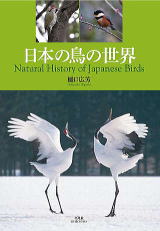
15. Higuchi, H. (ed.) 2013. Raptor Rsearch in Japan-Ecology and Conservation-.
University of Tokyo Press, Tokyo.
14. Higuchi, H. 2013. The Journey of Birds -Satellite-tracking Bird Migration-.
eBook. SELC, Tokyo. Japanese, Chinese, Korean, and Indonesian editions are also available.
https://books.apple.com/jp/book/the-journey-of-birds/id662449994
 
English edition Indonesian edition
13. Higuchi, H. 2013. Birds, Humans, and Nature: Celebrating the Diversity
of Life. University of Tokyo Press, Tokyo.
12. Higuchi, H. 2011. The Mystery of Red Eggs. Komine-shoten, Tokyo.
11. Higuchi, H. and Kurosawa, R. (ed.) 2010. Natural History of Crows.
Hokkaido University Press, Sapporo.
10. Higuchi, H. 2010. The Living Blue Planet -Biodiversity and Our Life.
Kagaku-dojin, Kyoto.
9. Higuchi, H. and Kurosawa, R. (ed.) 2009. Natural History of Birds. Hokkaido
University Press, Sapporo.
8. Higuchi, H. 2005. The Migration of Birds. NHK Publishing, Tokyo. Chinese edition (Fudan University Press, 2010), Korean edition (Bioscience
Publishing Co., 2010), English edition (SELC, 2013), Indonesian edition
(IPB Press, 2016).
7. Higuchi, H. and Morishita, E. 2000. What’s Wrong with Crows. Shogakkan,
Tokyo.
6. Higuchi, H. and Narusue, M. 1997. Living with Wetlands. Iwanami-shoten,
Tokyo.
5. Higuchi, H. (ed.) 1996. Conservation Biology. University
of Tokyo Press, Tokyo.
4. Higuchi, H. & Minton, J. (ed.) 1994.The Future of Cranes and Wetlands.
Wild Bird Society of Japan, Tokyo.
3. Higuchi, H. 1986. The Ecology of Birds. Asahi News Paper Publishing,
Tokyo.
2. Higuchi, H. 1986. The Secret of Red Eggs. Shisaku-sha, Tokyo.
1. Higuchi, H. 1978. Ecology and Evolution of Birds. Shisakusha, Tokyo.
Back
Invited lectures selected from 2008-
●“Bird migration and the conservation of the global environment”
24 February 2020
Special seminar for teachers of Battambang Teacher Education University
and Phnom Penh Teacher Education University
Battambang Teacher Education University lecture room, Battambang, Cambodia
● “Migration of raptors in East Asia”
11 October 2019
Asian Raptor Research & Conservation Network International Symposium
Frank Williams Museum of the Bird of Bali, Udayana University, Bali, Indonesia
● “Migration of raptors in East Asia: present state and future”
4 July 2017
Argos Asian Wildlife Tracking Workshop in Korea
National Institute of Biological Resources, Incheon, South Korea
● “Bird migration and biodiversity conservation in East Asia”
10 October 2016
National Biodiversity Science and Conservation Symposium
University of Chinese Academy of Sciences, Beijing, China
● “Bird migration and the conservation of the global environment”
“Conflicts between crows and humans”
3 August 2015
Special lecture on biodiversity conservation and management
Fudan University, Shanghai, China
● “Population trends of shorebirds in the East Asian-Australasian flyway”
13&14 November 2014
Japan-China-Australia Migratory Bird Treatise Conference
New Yallan Hotel Deqing, Wukang, China
● “Migration and conservation of birds in East Asia”
27 November 2013
International Symposium on Migratory Birds
Ulsan City Hall, Ulsan, South Korea
● “Bird Migration and biodiversity conservation in Asia”
4-11 September 2013
International Symposium on Avian Migration in the Northern Pacific: Breeding
and Stopover Sites in Changing Earth
Russian Academy of Science Far East Blanch, Yuzhno-Sakhalinsk, Sakhalin,
Russia
●“Population decline of tropical migratory birds in Japan”
17-19 March 2013
International Workshop on Forest Birds
Bukhan National Park, Seoul, South Korea
●“Impacts of climate change on the phenology, population and distribution of plants and animals”
1 September 2011
International Symposium on The Role of Ecological Institute:Ecological Approach to
Prepare Adaptive Strategy Against Climate Change
Seoul National University Hoam Faculty House, Seoul, South Korea
●“Impact of climate change on local economy of cherry blossom areas
15-19 June 2011
International Workshop on Climate Change and Phenology
Boston University and University of Connecticut, USA.
●“Migration and conservation of birds in East Asia”
24 February 2011
International Workshop on the Migratory Raptors in Asia
Bogor at CICO, Indonesia。
●“Bird migration and the conservation of the global environment”
24 November 2010
International Symposium on Migratory Birds of Eastern Asia and Wildlife
Jeju National University, Jeju, South Korea
●“Bird migration and the conservation of the global environment”
23 August 2010
Plenary Lecture at the 25th International Ornithological Congress
International Conference Hall, Canmos do Jordao, Brazil
●“Effects of climate change on the population trends of Whistling Swans”
6 June 2010
Climate Change and Phenology Workshop
Ewha Womans University, Seoul, South Korea
●“Bird migration linking nature and people in different countries”
12 December 2009
Tel Aviv University Migratory Bird Research Center 30th Anniversary Symposium
Tel Aviv University Auditorium, Tel Aviv, Israel.
●“Satellite tracking of Oriental Honey Buzzards in Japan”
5-9 November 2009
International Conference on the Migration and Biology of Honey Buzzards
Academia Sinica, Taipei, Taiwan.
●“Migration of birds and the conservation of the global environment”
6-9 October 2009
Argos Tracking 30th Anniversary Symposium
Sciences et de l'industrie, Paris, France.
●“Conflicts between crows and humans in urban areas”
“Ecology and conservation of migratory birds in East Asia”
February 2008
Seminars at the following universities
Tufts University, Dartmouth College, University of Connecticut, Manomet Center for Conservation Sciences, USA
●“Ecology and conservation of migratory birds in East Asia”
February 2008
Nuttall Ornithological Club Seminar
Museum of Comparative Zoology, Harvard University, Boston, USA
●“Ecology and conservation of migratory birds in East Asia”
February 2008
Department of Biology Seminar
Boston University, Boston, USA
Back
TOP |


